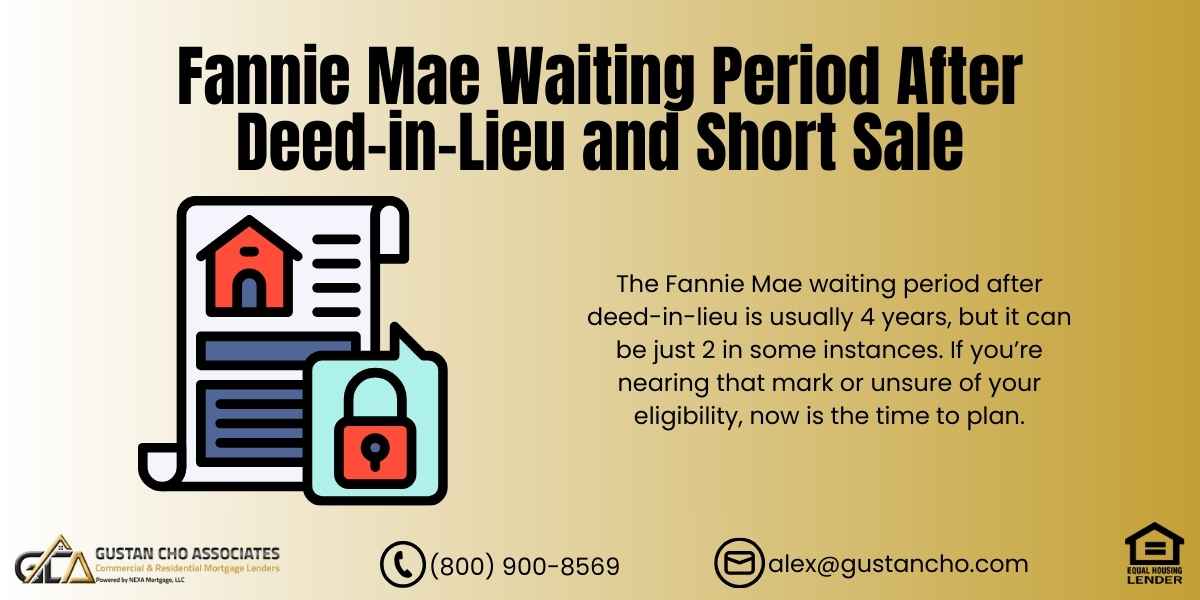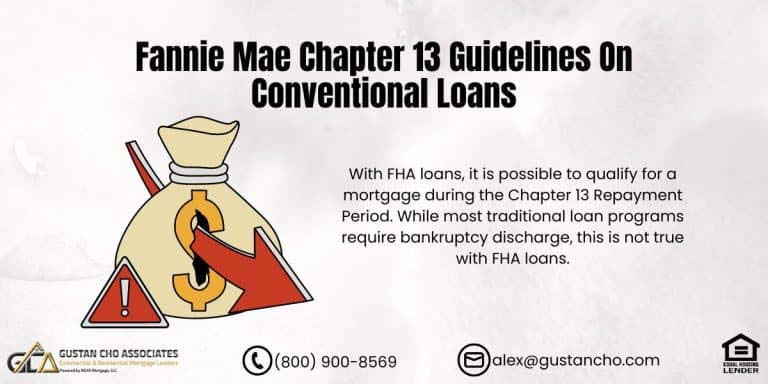From Setback to Comeback
A deed-in-lieu of foreclosure is one of the toughest financial decisions a homeowner can face. You may have turned over your home to the lender to avoid a full foreclosure. While it helped you close that chapter, the question remains: “When can I qualify for a conventional loan again?”
The good news is that Fannie Mae has clear rules, and with the right lender, you can bounce back faster than you think. In this guide, we’ll cover everything you need to know about the Fannie Mae waiting period after deed-in-lieu, your loan options, how exceptions work, and how Gustan Cho Associates can help you get approved the moment you’re eligible.
What Are Conventional Loans and Why Fannie Mae Rules Matter
The Federal Housing Finance Agency (FHFA) is the regulatory agency in charge of Fannie Mae and Freddie Mac. Conventional loans are just regular mortgages that don’t have any government backing. Instead, they must “conform” to standards set by Fannie Mae and Freddie Mac. Lenders follow these rules to sell their loans in the secondary market. If a loan doesn’t meet Fannie Mae guidelines, it can’t be sold, making those rules the baseline for conventional lending.
This is why understanding the Fannie Mae waiting period after deed-in-lieu is important. It tells you exactly when you’ll be mortgage-ready again under conforming loan programs.
Buy Again After Deed-in-Lieu or Short Sale
Fannie Mae guidelines allow financing after a set waiting period.
How Long Is the Fannie Mae Waiting Period After Deed-in-Lieu?
The current guideline in 2025 is:
- 4-Year Waiting Period: The Fannie Mae waiting period after deed-in-lieu is four years. During this timeframe, borrowers must demonstrate responsible financial behavior before qualifying for a conventional loan. This timeframe allows individuals to rebuild their credit and financial stability before seeking new financing options.
- 2-Year Waiting Period with Extenuating Circumstances: In cases involving documented extenuating circumstances, such as job loss, severe illness, or uncontrollable divorce, the Fannie Mae waiting period after deed-in-lieu can be reduced to just two years. This flexibility acknowledges the impact of unforeseen life events. It provides a pathway for qualifying sooner for a conventional loan while ensuring due diligence in credit assessments.
The clock starts on the date the deed transfers out of your name, not when you first miss payments.
This means if your deed-in-lieu was finalized in January 2021, you may be eligible for a new Fannie Mae mortgage in January 2025, or even as early as January 2023 if extenuating circumstances apply.
Fannie Mae Waiting Period After Deed-in-Lieu vs Foreclosure vs Short Sale
Many borrowers confuse the timelines for different housing events. Here’s a quick breakdown:
| Housing Event | Standard Fannie Mae Waiting Period | With Extenuating Circumstances |
| Deed-in-Lieu of Foreclosure | 4 years | 2 years |
| Short Sale (a.k.a. Pre-Foreclosure Sale) | 4 years | 2 years |
| Foreclosure | 7 years | 3 years (with restrictions) |
Key takeaway: A deed-in-lieu or short sale is treated more favorably than a full foreclosure.
What Counts as an Extenuating Circumstance?
Fannie Mae makes an exception for borrowers who went through financial hardship that was beyond their control. Examples include:
- Job loss or income reduction due to company closure or layoff
- Major medical bills or long-term illness
- Divorce or legal separation with a significant financial impact
- Death of a primary wage earner
Tip: You’ll need documentation to prove the hardship (termination letter, hospital records, court papers). Lenders also want to see that you’ve re-established credit and have a stable income now.
Down Payment Rules After the Waiting Period
Once the Fannie Mae waiting period after deed-in-lieu ends, here’s what you’ll need for a conventional loan:
- Minimum 5% down payment for most borrowers
- A 3% down payment is available for first-time homebuyers who have not owned a home in the last three years.
- A 20% down payment is not required anymore (Fannie Mae removed that older rule in 2014)
Gustan Cho Associates offers Fannie Mae programs with as little as 3% down, making it easier to re-enter the housing market.
Get Approved After a Short Sale
Even with past hardship, you may qualify sooner than you think
Credit Score Reqirements
Fannie Mae generally requires at least a 620 credit score for conventional loans. But here’s the reality:
- Some lenders impose overlays (stricter rules), asking for 640 or higher.
- Gustan Cho Associates has no overlays. If Fannie Mae allows it, we go by that rule.
That means if your score is 620 and you meet Fannie Mae waiting period after deed-in-lieu, you’re eligible with us even if other banks say no.
What About FHA, VA, and USDA Loans?
You may be wondering if other loan programs have shorter waiting periods. Here’s the comparison:
| Loan Type | Waiting Period After Deed-in-Lieu |
| Fannie Mae Conventional | 4 years (2 with extenuating circumstances) |
| Freddie Mac Conventional | Same as Fannie Mae |
| FHA Loan | 3 years |
| VA Loan | 2 years |
| USDA Loan | 3 years |
If you’re a veteran or eligible service member, a VA loan might be your fastest path back into homeownership. FHA loans also allow re-entry sooner than conventional loans in many cases.
How Gustan Cho Associates Helps Borrowers After a Deed-in-Lieu
At Gustan Cho Associates, we specialize in helping borrowers who have gone through housing events like deed-in-lieu, foreclosure, or short sale. Unlike big banks and retail lenders, we:
- Follow Fannie Mae and Freddie Mac guidelines with no overlays
- Approve borrowers down to 620 credit scores (some cases lower with FHA/VA)
- Offer FHA, VA, USDA, Conventional, Jumbo, and Non-QM loans
- Provide full credit approvals upfront (not just pre-quals) so you shop with confidence
When other lenders say, “Come back later,” we say, “Let’s see how soon we can qualify you.”
Common Mistakes Borrowers Make After a Deed-in-Lieu
1. Assuming the Waiting Period Starts at the Last Missed Payment
Many borrowers mistakenly believe their waiting period for obtaining a new mortgage begins with their last missed payment. In reality, the waiting period actually starts when the deed transfer occurs, which can significantly affect their eligibility timeline.
2. Not Rebuilding Credit
After a deed-in-lieu, borrowers must focus on rebuilding their credit. Even if the required waiting period passes, lenders will look for evidence of re-established creditworthiness before approving a new loan, making proactive credit repair essential.
3. Thinking Every Lender Follows the Same Rules
Borrowers often assume that all lenders have identical guidelines regarding loan applications after a deed-in-lieu. However, many lenders impose additional requirements or “overlays” beyond the standard regulations, which can impact the approval process.
4. Waiting Too Long to Plan
Failing to plan ahead can lead to missed opportunities for borrowers seeking a mortgage after a deed-in-lieu. It’s advisable to consult with a lender at least a year before becoming eligible to ensure preparedness and a clear pathway to re-entering the housing market.
Step-by-Step Guide to Qualify for a Conventional Loan After Deed-in-Lieu
- Check the date of your deed transfer to confirm when your waiting period ends.
- Pull your credit report and review scores.
- Work on rebuilding credit: pay bills on time, keep balances low, and add new positive tradelines if needed.
- Gather documents: proof of income, tax returns, W-2s, and any hardship letters.
- Get pre-approved with Gustan Cho Associates. We’ll run DU/LP findings (Automated Underwriting System).
- Shop with confidence knowing your approval is backed by underwriting.
Final Thoughts
Life after a deed-in-lieu can feel like starting over. But with time, patience, and the right lender, homeownership becomes possible again.
The Fannie Mae waiting period after deed-in-lieu is usually 4 years, but it can be just 2 in some instances. If you’re nearing that mark or unsure of your eligibility, now is the time to plan.
At Gustan Cho Associates, we don’t believe in overlays or unnecessary denials. If Fannie Mae allows it, we make it happen. Borrowers who need a five-star national mortgage company licensed in 50 states with no overlays and who are experts on the Fannie Mae waiting period after deed-in-lieu, please contact us at 800-900-8569, text us for a faster response, or email us at alex@gustancho.com. The team at Gustan Cho Associates is available 7 days a week, on evenings, weekends, and holidays.
What’s the waiting period after a short sale?
Typically 4 years, though certain circumstances may shorten or extend it.
Frequently Asked Questions About Fannie Mae Waiting Period After Deed-in-Lieu:
Q: What is the Fannie Mae Waiting Period After Deed-in-Lieu?
A: The Fannie Mae waiting period after deed-in-lieu is usually 4 years before you can get a new conventional loan.
Q: Can the Fannie Mae Waiting Period After Deed-in-Lieu be Shorter?
A: Yes. If you had serious hardships like job loss or medical bills, the Fannie Mae waiting period after deed-in-lieu may be just 2 years with proof.
Q: When Does the Fannie Mae Waiting Period After Deed-in-Lieu Start?
A: The Fannie Mae waiting period after a deed-in-lieu starts when the deed officially transfers from your name, not when you stop making payments.
Q: What Down Payment is Needed After the Fannie Mae Waiting Period After Deed-in-Lieu?
A: After the Fannie Mae waiting period after deed-in-lieu, you may qualify with as little as 3% to 5% down, depending on your situation.
Q: Do I Need a High Credit Score After the Fannie Mae Waiting Period After Deed-in-Lieu?
A: No. Fannie Mae requires a 620 minimum credit score. Gustan Cho Associates follows this rule without any extra overlays.
Q: Can I Use FHA or VA Loans if the Fannie Mae Waiting Period After Deed-in-Lieu is Not Over Yet?
A: Yes. FHA loans require only 3 years, and VA loans just 2 years, which may be sooner than the Fannie Mae waiting period after deed-in-lieu.
Q: What Happens if My Bank Still Says No After the Fannie Mae Waiting Period After Deed-in-Lieu?
A: Some banks add their own rules called overlays. Gustan Cho Associates does not. We go by the real Fannie Mae waiting period after deed-in-lieu.
Q: Can I Buy a House Right at the End of the Fannie Mae Waiting Period After Deed-in-Lieu?
A: Yes. As soon as the Fannie Mae waiting period after deed-in-lieu ends, you may qualify if your income, credit, and documents check out.
Q: Do I Need to Prove Extenuating Circumstances to Shorten the Fannie Mae Waiting Period After Deed-in-Lieu?
A: Yes. You’ll need documents like job loss letters, divorce papers, or medical bills to show why you qualify for the 2-year rule.
Q: Is There Another Option if I haven’t Yet Met the Fannie Mae Waiting Period After Deed-in-Lieu?
A: Yes. Non-QM loans, like bank statement or DSCR loans, may let you buy sooner without waiting for the full Fannie Mae waiting period after deed-in-lieu.
This article about “Fannie Mae Waiting Period After Deed-in-Lieu and Short Sale” was updated on August 29th, 2025.
Can I qualify sooner with extenuating circumstances?
Possibly—Fannie Mae allows exceptions for documented hardship.










